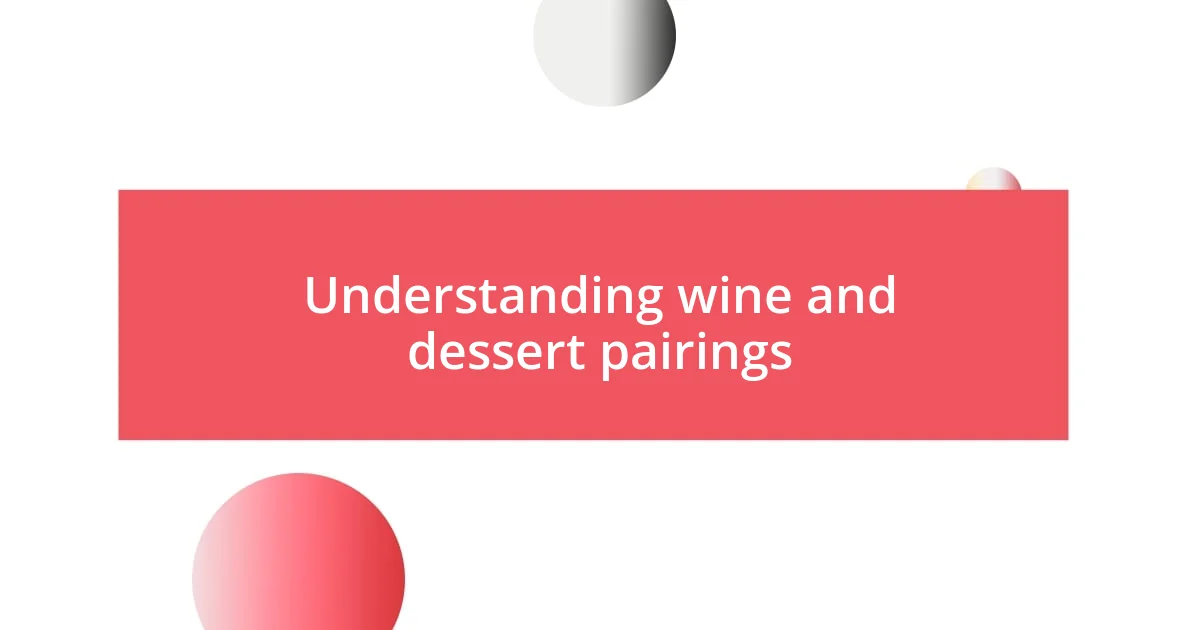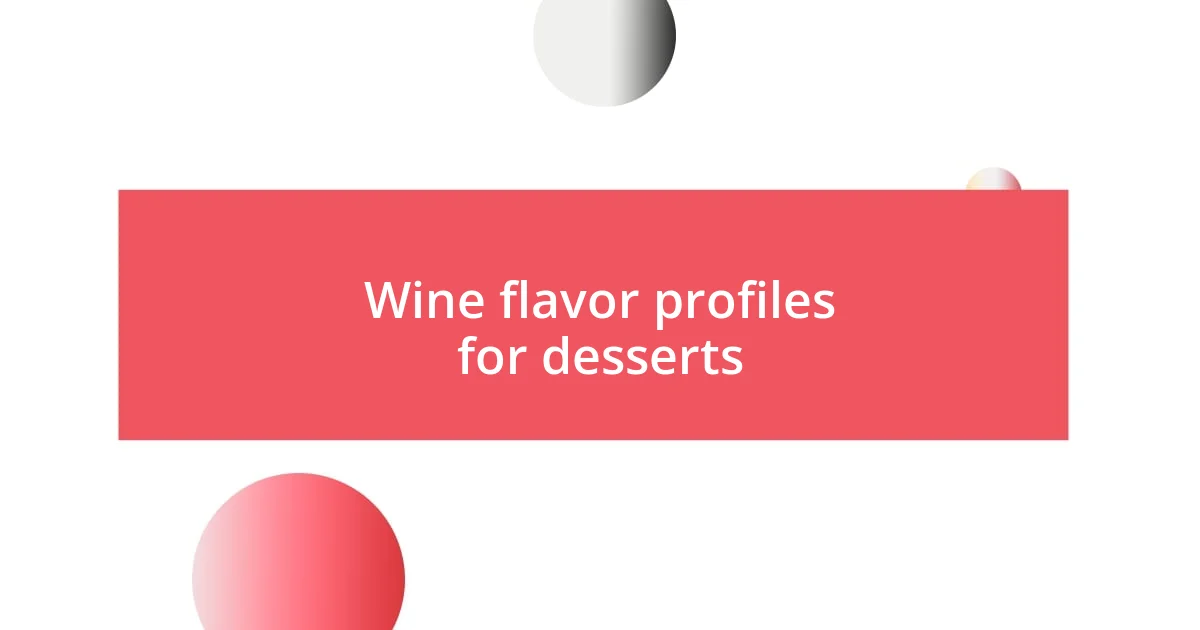Key takeaways:
- Successful wine and dessert pairings hinge on balancing sweetness and acidity, with careful attention to the intensity of both elements.
- Choosing the right dessert wine involves matching sweetness levels, considering acidity, and looking for complementary flavors to enhance the dessert experience.
- Common mistakes in pairing include selecting wines that overshadow desserts, misjudging sweetness levels, and overlooking the importance of texture balance between the wine and dessert.

Understanding wine and dessert pairings
Pairing wine with rich desserts is more than just a culinary choice; it’s an art form that brings out the best in both elements. I remember the first time I paired a luscious chocolate cake with a robust port. The experience was transformative—the creamy texture of the cake mingled beautifully with the wine’s sweetness, elevating both flavors to new heights. Have you ever wondered how a simple sip can change your perception of dessert?
The key to successful pairings often lies in balancing sweetness with acidity. When I tried a rich bread pudding accompanied by a late harvest Riesling, the wine’s acidity cut through the heaviness of the dessert, making each bite feel lighter. It’s fascinating, isn’t it? I often think about how the right wine can create a dialogue between flavors, enhancing the overall experience.
It’s also important to consider the intensity of both the wine and the dessert. A delicate panna cotta, for example, deserves a soft, fragrant wine like Moscato, which won’t overpower its subtle flavors. Have you ever felt overwhelmed by a pairing that didn’t quite match? I know I have, and it truly highlights how crucial this harmony is in creating memorable moments at the table.

Selecting suitable dessert wines
Selecting the right dessert wine can heighten the enjoyment of a sweet dish. I recall an enchanting evening where my friends and I savored a rich tiramisu with a glass of Vin Santo. The wine’s nutty notes perfectly complemented the chocolate and coffee layers, creating a harmonious experience that felt almost celebratory. When choosing a dessert wine, consider the flavor profile of the dessert and aim for a wine that matches or contrasts those flavors.
Here are some tips for selecting suitable dessert wines:
- Match sweetness levels: Opt for wines sweeter than the dessert.
- Consider acidity: A wine with good acidity can balance heavy flavors.
- Look for complementary flavors: Think of scents and tastes that enhance each other.
- Experiment with regions: Different regions produce unique dessert wines—try something new!
When I paired a chocolate tart with an intense Cabernet Sauvignon Ice Wine, I learned firsthand how daring combinations sometimes yield the most delightful surprises. It’s thrilling to let your palate wander, trying new pairings and discovering those magical moments that linger long after the last sip.

Characteristics of rich desserts
Rich desserts are often characterized by their indulgent textures and bold flavors. You might find that these desserts frequently contain ingredients like cream, chocolate, or caramel, which contribute to their luxurious mouthfeel. I remember indulging in a dense chocolate mousse, where each spoonful felt like a velvet embrace, making it hard to resist another bite. Isn’t it fascinating how certain flavors can capture an emotion or memory in such a delightful way?
Another hallmark of rich desserts is the balance of sweetness and richness. Think of a decadent cheesecake bursting with cream cheese and sugar—its rich nature calls for a complementary wine that balances that sweetness. Personally, my experience with a cherry clafoutis topped with a dollop of whipped cream was a revelation. The combination of the pastry’s richness with a slightly tart wine made the dessert feel lighter and so much more enjoyable. Have you experienced that perfect pairing that made a dessert completely unforgettable?
Lastly, the visual appeal of rich desserts often enhances their allure. Layers of chocolate ganache, vibrant fruit centers, or creamy custards create a feast for the eyes as well as the palate. When I was served a beautifully layered tiramisu in a rustic restaurant, it was not just about the taste; the presentation elevated my anticipation. The aesthetic of a dessert can intensify your craving and draw you into the experience. Have you ever found yourself captivated before even taking that first bite?
| Characteristic | Description |
|---|---|
| Texture | Indulgent and creamy, often velvety or smooth |
| Flavor | Bold, sweet, and rich, with high-quality ingredients |
| Visual Appeal | Often beautiful and layered, enticing to the eye |
| Balance | Sweetness balanced with acidity or lightness |

Wine flavor profiles for desserts
When it comes to pairing wine with rich desserts, understanding the flavor profiles is key. For instance, I vividly remember savoring a luscious pecan pie with a glass of late harvest Sauvignon Blanc. The wine’s honeyed sweetness and bright acidity cut through the pie’s richness, creating a perfect balance. Have you ever considered how a wine’s sweetness can either elevate or clash with your dessert? This interplay is what makes each pairing an exciting adventure.
Certain wines carry flavor profiles that naturally complement desserts. A classic choice, like Pedro Ximénez sherry, offers a deep, syrupy richness with notes of fig and date that beautifully accentuates desserts featuring nuts and caramel. Similarly, I once paired an orange-infused Moscato with a cream-filled pastry, and the citrus undertones awakened the entire dish! It’s moments like these that remind me of the magical dance between food and wine; how they can enhance each other to create an exquisite tasting experience.
Don’t overlook the role of aromatic wines, as they can provide alluring contrasts too. For instance, I once encountered a delightful pairing of a rich chocolate cake with a sparkling Rosé. The wine’s effervescence added a refreshing lift, cutting through the cake’s dense flavor. It wound up being a surprisingly delightful combination, sparking my curiosity about what other unexpected pairings might work well together. Have you found a pairing that challenged your assumptions and left you craving more?

Tips for pairing sweet wines
When pairing sweet wines, the key is to ensure that the wine is at least as sweet as the dessert. I learned this lesson one evening while enjoying a warm chocolate lava cake. I paired it with a rich port, and it was magical. The wine’s sweetness mirrored the dessert, making each bite even more decadent. Have you ever experienced that lovely moment where the flavors just surrender to one another?
Another tip is to consider the wine’s acidity. A wine with a bright acidity can provide a refreshing contrast to heavy desserts. For example, I once had a glass of Riesling with a warm bread pudding. The wine’s acidity cut through the dish’s richness, leaving a delightful sensation that balanced the intense sweetness. Have you tried pairing a dessert with a wine that had surprising acidity, revealing new layers of flavor?
Lastly, think about the flavor notes in the dessert and try to match them with the wine. I recall pairing a crème brûlée with an ice wine that had hints of apricot. It was fascinating how the apricot notes enhanced the dish’s caramelized sugar topping. It felt like a burst of sunshine on my palate! Have you thought about how a simple flavor match could elevate your dessert experience?

Serving temperature for dessert wines
Serving dessert wines at the right temperature can profoundly impact the overall tasting experience. For instance, I find that most dessert wines, such as Sauternes or late harvest Rieslings, shine best when served chilled between 45°F to 50°F (7°C to 10°C). This cooler temperature lets their vibrant sweetness and acidity blend beautifully, enhancing both the wine’s character and the dessert it accompanies. Have you ever noticed how a slight chill can transform a wine, making it more refreshing?
On occasion, I’ve served a luscious Tokaji at around 50°F, and it was a revelation. The wine’s honeyed layers unfurled beautifully, providing a delightful contrast to a rich chocolate tart. The warmth of the dish paired with the slightly cooler wine created such a harmonious balance—every sip was a reminder of why serving temperature matters. Have you had an experience where adjusting the temperature of a wine changed how you perceived its flavors?
Conversely, a slightly warmer serving temperature might enhance the complexity of wines like Pedro Ximénez. By allowing it to rest at about 55°F (13°C), those rich notes of raisin and fig come to the forefront, melding seamlessly with a rich dessert like bread pudding. I’ve found that this approach often sparks excitement among my guests as they begin to uncover the intricate layers within the wine. Isn’t it fascinating how temperature can play such a pivotal role in our tasting journey?

Common mistakes in pairing wine
When pairing wine, one common mistake is opting for a wine that overshadows the dessert instead of complementing it. I remember serving a flamboyant Cabernet Sauvignon with a delicate lemon tart, and it was a total mismatch. The wine’s bold tannins completely engulfed the citrus notes, leaving the dessert feeling diminished. Have you ever paired a wine that was just too strong and lost the beauty of the dessert?
Another frequent error is not considering the wine’s sweetness level. I once thought a dry white might work with a slice of velvety cheesecake, but it fell flat. The dessert needed a sweet spark to dance with its creaminess. Have you experienced that moment of realization where you pick the wrong sweetness, and the entire pairing just fizzles out?
Lastly, many people overlook the importance of balancing textures. Pairing a smooth dessert like panna cotta with a wine that has harsh tannins can create a jarring contrast. I learned this during a dinner party when I served a full-bodied Malbec with a silky mousse. It just didn’t flow; the textures clashed instead of harmonizing. Isn’t it revealing how crucial textures can be in creating a delightful wine and dessert combination?













